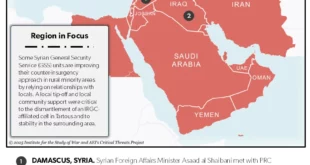Eastern Syria sits at the crossroads of critical policy decisions in Washington. The region is at the center of an escalating crisis in U.S.-Turkey relations, while maintaining America’s presence there blocks Iranian and Russian gains in Syria. It also is key to keeping ISIS defeated. Washington should see eastern Syria as one of the most important strategic pieces of “real estate” to emerge out of the last half-decade of conflict in the Middle East.
The area of northeast Syria where the U.S. today plays a critical role, roughly the size of West Virginia, is now a kind of Gordian Knot. While American adversaries, such as Russia or Iran, have a clear goal in Syria, keeping the Bashar al-Assad regime in power and entrenching their influence, the U.S. policy goal is less clear.
Turkey, a historic U.S. ally, recently threatened to launch a military operation into eastern Syria against key U.S. partners who helped defeat the so-called Islamic State, leaving Washington with a devil’s bargain: leave eastern Syria and watch five years of fighting ISIS and working with local forces collapse, or continue to fuel a crisis with Turkey. The U.S. chose a temporary solution, telling Ankara it would work on a “safe zone” along the Syria-Turkey border.
Is eastern Syria just a sunk cost for Washington? The reality is that the U.S., partly by accident and partly by mission creep, has found itself sitting astride the most important nexus of four foreign policy axes connecting the Middle East and the world. One is Iran’s regional strategy, another is Russia’s plans and a third is Turkey’s goals. Lastly, the area keeps ISIS contained. It’s because it ties in to so many agendas that this triangle of land is so important, and so combustible.
It didn’t begin this way. Northeast Syria was a poor, neglected part of the country for most of the 20th century. The Obama administration deepened U.S. involvement in the Syrian conflict initially through support for anti-Assad rebels but shifted to focus on defeating Islamic State after 2015. Eventually a coalition of 75 countries signed on to fight ISIS in Iraq, with a handful supporting U.S. anti-ISIS operations in Syria.
“ISIS lost its last major foothold in March 2019 but thousands of its former fighters formed sleeper cells.”
It was an open-ended war with a mandate to defeat the extremists, morphing into supporting the Syrian Democratic Forces as the central partner on the ground fighting ISIS. The Pentagon wanted a “by, with and through” approach that implied a small U.S. footprint, backing mostly Kurdish fighters. President Donald Trump decided to withdraw from Syria in December 2018, then slowed down. ISIS lost its last major foothold in March 2019 but thousands of its former fighters formed sleeper cells.
A Pentagon report released on Aug. 6 says the U.S. has completed a partial withdrawal at a time when the SDF “needed training and equipping to respond to ISIS resurgent cells.” Efforts at stabilization and security, which foresee the training of 110,000 local forces, are continuing but are strained by contradictory policies. U.S. efforts to get the U.K., Germany or France to commit troops to backfill the slow U.S. withdrawal and support a safe zone have come to naught. Leaving eastern Syria now means creating a vacuum and giving ISIS breathing space. It would also mean abandoning partners on the ground, reducing U.S. influence.
A second U.S. policy in Syria emerged in the fall of 2018. Although the Trump administration ended support for the rebels, National Security Adviser John Bolton said the U.S. would remain in Syria until Iran left. Officials realize that controlling a swath of Syria, including a military base at Tanf near the Jordanian border, puts pressure on Iran’s support for the Syrian regime and its entrenchment in Syria. America’s presence stymies the Islamic Revolutionary Guard Corps, keeping it from expanding its activities across Iraq and Syria. This is a key concern for Israel which has carried out more than 1,000 airstrikes on Iranian targets in Syria to interdict Iranian support to Hezbollah.
Turkey has slammed the U.S. role in Syria, accusing it of training terrorists linked to the Kurdistan Workers Party (PKK) and creating a “terrorist corridor” that threatens Ankara. Washington attempted to assuage Ankara’s anger, putting a bounty on three PKK leaders in 2018 and agreeing to work jointly with Turkey on a safe zone along the Syrian border. But the tensions with Turkey include other, perhaps larger problems, such as Ankara’s acquisition of the Russian S-400 air defense system.
Some of these contretemps stem in part from Turkey’s dim view of U.S. policy in eastern Syria. In the process, Russia and Turkey have grown closer. Iran also now boasts of its growing ties with Turkey.
Ankara has threatened repeatedly over the last year to launch a military operation into eastern Syria where U.S. forces are based, even saying it has informed Moscow of its intentions.
The U.S. warned it against unilateral action on August 6 and promised to do more to create a “safe zone” for Turkey.
Such solutions are short-term, and Washington has been cagey about playing a grander role, despite its influence on the ground. Meanwhile Iran, Russia and Turkey regularly meet in the framework of the Astana peace talks on Syria, excluding the U.S.
Eastern Syria is now a hinge on which the door to U.S. influence in the region opens or shuts. It is intricately linked to stability in the Kurdistan Regional Government in Iraq, which is a close U.S. partner.
American allies such as the United Arab Emirates, whose regional policies tend to be at odds with Turkey and Qatar, oppose Turkey’s desire to launch an operation. “There is no excuse for Turkish control of Syrian land,” The National in the UAE argued on August 8, building on a similar editorial on July 14. But come what may, the White House doesn’t want another “forever war” like Afghanistan.
Areas from Raqqa to Qamishli in Syria are no longer just an area to be stabilized against the resurgence of ISIS, or a region used as a bargaining chip with Iran. It is too combustible for either simple mission. Moscow, Tehran and Damascus are eager for American humiliation and seeking to exploit U.S.-Turkey tensions. Washington allies, from the Gulf to Israel, would see a setback if the U.S. withdraws suddenly. That means the U.S. also has leverage over these allies and could encourage more buy-in from Riyadh or Abu Dhabi, to support stabilization and reconstruction. They also oppose Iran’s growing influence, and are at odds with Turkey, so for them northeast Syria is important.
Recognizing eastern Syria as more than the sum of its parts is the best way to understand the long-term challenge there. It is the strategic real estate in the Middle East upon which the ambitions of four powers rest, and where U.S. strategy is made or broken.
 Eurasia Press & News
Eurasia Press & News


